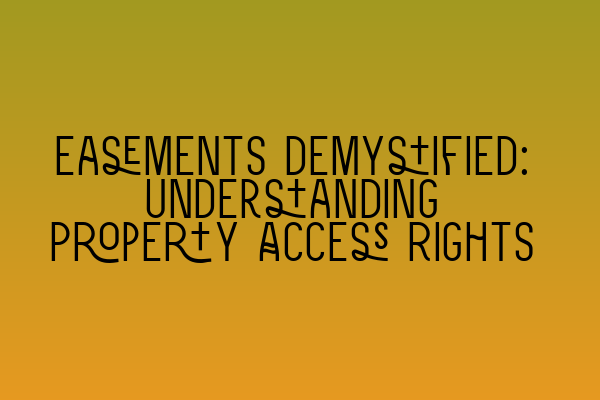Easements Demystified: Understanding Property Access Rights
Introduction:
When it comes to property ownership and rights, understanding easements is crucial. Whether you are a homeowner or a property investor, having a clear understanding of easements and their implications can save you from legal disputes and ensure smooth property transactions. In this blog post, we will delve into the intricacies of easements, demystify the concept, and provide you with valuable insights to navigate property access rights.
What are Easements?
An easement is a legal right to use another person’s land for a specific purpose. It grants a non-possessory interest in someone else’s property. Easements are necessary to provide access to land or to permit specific activities on the land. They create a legal relationship between the owner of the servient estate (the land being used) and the owner of the dominant estate (the land benefiting from the easement).
Types of Easements:
1. Right of Way Easements:
One of the most common types of easements is the right of way. This type of easement grants a person or entity the right to pass over someone else’s land to access their own property. Right of way easements can be created for various purposes, such as pedestrian access, vehicle access, or utility services. It is essential to be clear about the scope and limitations of a right of way easement to avoid any potential conflicts.
2. Utility Easements:
Utility easements allow utility companies to access and maintain infrastructure on private property. These easements are typically created to allow gas, electricity, water, or sewer lines to be installed and maintained. Property owners must understand the extent of the utility easement and ensure that the utility company adheres to the agreed-upon terms.
3. Easements by Necessity:
Easements by necessity arise when a property is landlocked, meaning it has no direct access to a public road or thoroughfare. In such cases, a court may grant an easement to ensure the property owner can access their land. Easements by necessity are often temporary and terminate once alternative access becomes available.
4. Easements by Prescription:
Easements by prescription, also known as prescriptive easements, refer to rights granted over another person’s land through continuous, open, and uninterrupted use for a specified period. These easements are similar to adverse possession, where someone gains ownership of land through long-term occupation. Establishing a prescriptive easement often involves proving specific legal elements, such as adverse use and the intention to claim the right.
Creation and Termination of Easements:
Easements can be created by express agreement, implied agreement, or by operation of law. Express easements are created through written agreements, such as deeds or contracts, explicitly defining the rights and obligations of the parties involved. Implied easements, on the other hand, are created when it is reasonably necessary for the use and enjoyment of the dominant estate. Easements can also be created by way of necessity or by prescription, as discussed earlier.
Easements can be terminated or extinguished under certain circumstances. Termination may occur through the release or abandonment of the right, by agreement between the parties involved, or by ceasing to use the easement for an extended period. Changes in the use of the servient land or the dominant land, such as subdivision or merger, can also lead to the termination of easements.
Importance of Easement Research:
Before purchasing a property or undertaking any construction or development activities, it is crucial to conduct thorough research on existing easements. Easement research involves reviewing property records, title searches, and relevant legal documents to understand the rights and restrictions associated with the property. Additionally, consulting with a property law expert can provide valuable insights and ensure compliance with legal requirements.
Conclusion:
Easements play a significant role in property law, granting essential access rights and delineating boundaries between neighboring properties. Understanding the different types of easements, their creation and termination, and the importance of conducting easement research can help property owners and investors navigate potential legal pitfalls. By being well-informed and seeking professional advice when necessary, you can protect your property rights and make informed decisions regarding property transactions. To enhance your knowledge and skills in property law, we recommend exploring the related articles below:
– SQE 1 Practice Exam Questions
– SQE 1 Practice Mocks FLK1 FLK2
– SQE 2 Preparation Courses
– SQE 1 Preparation Courses
– SRA SQE Exam Dates
At SQE Property Law & Land Law, our team of solicitors and property law experts is here to assist you with any queries or legal requirements. Contact us today for professional guidance in navigating property access rights and ensuring smooth property transactions.
